Description
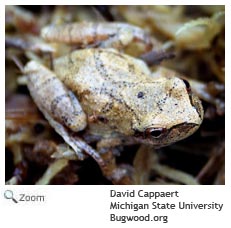 The spring peeper is a tiny tree frog between ¾-1½ inches in length. It is usually green, gray, olive, or brown in color. It has an The spring peeper is a tiny tree frog between ¾-1½ inches in length. It is usually green, gray, olive, or brown in color. It has an
X-shaped mark on its back and banded markings on its legs. The word crucifer in their Latin name Pseudacris crucifer means cross-bearer. In some spring peepers these markings are very light.
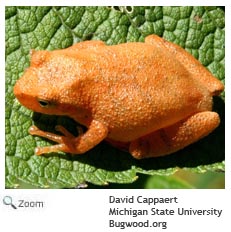 The spring peeper has a white or cream colored belly and webbed feet with sticky toe pads that it uses to cling to trees and plants.
Although the spring peeper is a tree frog and a good tree climber, it spends a lot of time on the ground! The spring peeper has a white or cream colored belly and webbed feet with sticky toe pads that it uses to cling to trees and plants.
Although the spring peeper is a tree frog and a good tree climber, it spends a lot of time on the ground!
Range
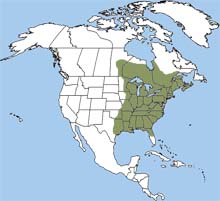 The spring peeper is found in most of the eastern United States and Canada, including New Hampshire. The spring peeper is found in most of the eastern United States and Canada, including New Hampshire.
| |
Habitat
The spring peeper is found in marshy woodlands, ponds, and swamps.
Diet
The spring peeper eats small insects like flies, beetles, ants, and spiders.
Life Cycle
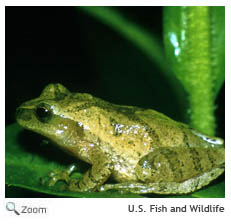 The spring peeper first mates when it is three years old. Mating season begins in March and can last through June. The female lays up to 1,000 eggs on twigs and leaf litter in shallow water. The eggs hatch in 6-12 days. The tadpoles begin to change into frogs in the late summer.
The spring peeper spends the winter hibernating under logs or under the loose bark of a tree. The spring peeper first mates when it is three years old. Mating season begins in March and can last through June. The female lays up to 1,000 eggs on twigs and leaf litter in shallow water. The eggs hatch in 6-12 days. The tadpoles begin to change into frogs in the late summer.
The spring peeper spends the winter hibernating under logs or under the loose bark of a tree.
Behavior
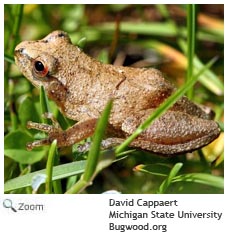 The spring peeper gets its name from its call. In the spring, males perch on grasses, sedges, and branches near water and call out for mates with a high pitched, single note "peep" that they repeat 15-25 times a minute. Usually, more than one peeper calls at the same time, and their calls sound like jingling bells. In some places, the sound of spring peepers is seen as one of the first signs of spring! Some people mistake the call for a cricket call, but crickets are usually not heard in the early spring. Only the male spring peeper makes the peeping call. The spring peeper gets its name from its call. In the spring, males perch on grasses, sedges, and branches near water and call out for mates with a high pitched, single note "peep" that they repeat 15-25 times a minute. Usually, more than one peeper calls at the same time, and their calls sound like jingling bells. In some places, the sound of spring peepers is seen as one of the first signs of spring! Some people mistake the call for a cricket call, but crickets are usually not heard in the early spring. Only the male spring peeper makes the peeping call.
|




 The spring peeper is found in most of the eastern United States and Canada, including New Hampshire.
The spring peeper is found in most of the eastern United States and Canada, including New Hampshire.

